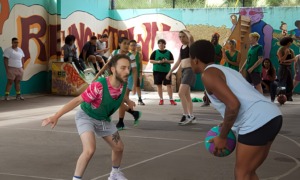
Screenshot of Autism Society of America's Coronavirus Information Series
Autism Society president Chris Banks (left) interviewed Berkeley student Hari Srinivasan in August about how he was coping with the pandemic.
University of California, Berkeley graduate student Hari Srinivasan had finally begun to immerse himself in campus life last year — no easy feat for an autistic person who is mostly nonspeaking.
Then the COVID-19 pandemic hit, and suddenly the university system moved everything, including classes, online.
“I was enjoying the social aspects of college, building community with student organizations and even attending parties,” Srinivasan said with the help of a text-to-talk device, during an interview with Autism Society President Chris Banks on Aug. 27, 2020. “So this complete lack of face-to-face contact is a huge setback for me on the social gains I was making,”
The pandemic has been disruptive for almost everyone, but its disruptions have been particularly difficult for autistic youths, who thrive on routine.
Srinivasan and others like him have had to spend the past year finding creative ways to cope.
“This pandemic is like collective societal trauma and autism issues just exacerbates its effects,” he said. “… Many of us autistics don’t like too much uncertainty and this pandemic is like the ultimate uncertainty.”
Facing challenges
Having a stable, predictable routine helps many autistic people thrive in a world more geared toward neurotypical people.
Kay Tilden Frost, an autistic writer from Washington, D.C., who is raising two autistic children, said researchers believe this is because autistic people sometimes struggle to filter the flood of external information that comes to us through our five senses all the time.

Kay Tilden Frost
“This creates a ‘busy world,’ which is loud, confusing, and often painful,” Frost said via email. “For autistic people of all ages, we often find a routine to be a useful adaptation because it limits stimuli to things that are well known and often pleasant.”
But maintaining a routine has been nearly impossible during a year of stay-at-home orders, remote learning and other pandemic-related changes. Add to that the stress of wondering whether your, your family or your friends will contract the coronavirus and become ill.
“Parents [of autistic children] may notice an increase in symptoms of anxiety and irritability such as mood fluctuation, reduced attention, pacing, refusal to participate in activities or to comply with requests,” said Donna Murray, vice president of clinical programs for Autism Speaks.
Schedules have changed abruptly, and the few things that continue as scheduled now often require a mask or other face covering. That adds another difficult disruption for autistic people, many of whom don’t like the sensation of having something over their nose and mouth.
Frost said her daughter still finds it intolerable, almost to the point of being tortuous.
“She absolutely will not go back to school while she has to wear a mask,” Frost said.
Srinivasan said in the interview that since the pandemic began he has frequently been waking up disoriented, and his proprioception — or the ability to perceive where his body is in space, has also been affected.
Coping mechanisms
There are several ways to make it easier for autistic youths to cope with the changes wrought by the pandemic, according to Johns Hopkins Medicine, including using visual aids and social narratives (short, simple stories) to help them process information about why their lives are changing, or why they’re now expected to keep their distance from other people.
Other calming strategies include deep breathing, getting physical exercise, listening to music or holding a favorite toy or other item.

Donna Murray
Murray said printed schedules with pictures or words can be useful for autistic children who are now remote learning. Autism Speaks has downloadable examples on its website.
“The use of schedules and visual supports can be a concrete way to communicate routine, activities and expectations, she said.
Srinivasan said in the interview that writing has been “personally cathartic and therapeutic” for him during the pandemic. He keeps a journal of “daily positives,” and he’s also found it helpful to do mindfulness exercises and map out his schedule for the next day before going to bed every night.
On the other hand, Frost said her 13-year-old daughter has found it better to not try to make a schedule, outside of the one that’s imposed on her by virtual school.
“If it gets disrupted, that’s far worse for her than just allowing her day to be a little random,” Frost said.
Which points to something Frost said is critically important to remember: Just as autism varies from person to person, coping strategies must vary as well. What is helpful for one individual may not be helpful for another, so it’s important to individualize approaches, including when and how often to send autistic kids back to in-person classes as schools begin to open back up.
It’s also important for adults to stop and evaluate whether they’re trying to address kids’ anxiety or their own, Frost said. For example, she said she was initially worried that her kids would not be able to function well in virtual school without going through the routine of getting up and putting on their uniforms. But she quickly found that getting to stay in pajamas for school was actually comforting for them, so she let them do it.
“It’s crucial to let autistic kids take the lead right now in every way possible, especially since their world is so out of control,” Frost said.
Silver linings
Frost and Srinivasan also both said that the pandemic, despite all its challenges, has provided some positives for young autistic people.
Frost said hyperfocus — the ability to zero in completely on one task, which is a common aspect of autism — has proven extremely valuable for her kids because it allows them to escape the stresses of the pandemic for awhile.
Srinivasan said in the interview that taking classes online, while not as social, does have something of an “equalizing” effect, especially in large lectures. Being mostly nonverbal is less of an obstacle to participation when you’re learning via a video stream with a chat function, and if he’s having trouble controlling his physical movements and he doesn’t want his classmates to see that, he can just cut his video feed.
With many more schools and employers now embracing telework, that will likely only increase opportunities for autistic people in the future, he said.
“Going forward I think for autistics a hybrid model of onsite and remote, whether in education or employment, may be the way to go,” Srinivasdan said. “This will help us manage some of the stresses of constant face-to-face social interaction, etc. Our pandemic has shown us that such models are doable.”





























